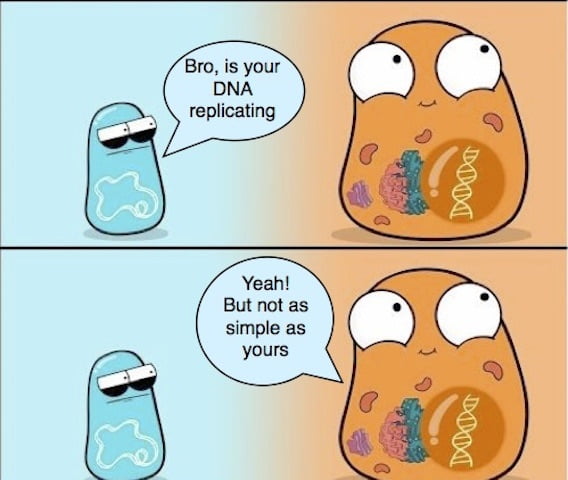Introduction:
DNA Replication is a vital molecular process of duplicating the genetic material. During cell division, the newly formed DNA is transferred into the daughter cell. DNA is passed from one generation to another because it consists of genes that carry the information of protein synthesis. To carry out DNA replication, the cell needs replication machinery. The replication machinery comprises of series of proteins and enzymes. The steps of replication are initiation, elongation and termination and found to be common in both prokaryotes and Eukaryotes.
In Prokaryotes, the DNA is present in cytoplasm in the form of Nucleoid. Whereas, in eukaryotes the DNA is present inside the membrane bound organelle called as nucleus. As eukaryotes are complex than prokaryotes, the similar complexity is also observed in their replication process.
The replication process in prokaryotes is very well explained in an article of DNA replication in Eicherichia coli
The following table differentiate the replication process in prokaryotes eukaryotes:
| Prokaryotic DNA Replication (E.coli) | Eukaryotic DNA Replication (Yeast) | |
| Site of Replication | Cytoplasm | Nucleus |
| Shape of Chromosome | Circular | Linear |
| Number of Chromosome | Single | 16 chromosome |
| Number of origin | Single | Multiple |
| Origin is called as | OriC | Autonomous Replicating sequences (ARS) or replicators |
| Origin length | 245 bp | approx. 150 bp |
| Replication direction | Unidirectional or Bidirectional | Bidirectional |
| Protein that initiate DNA replication | DnaA and DnaB protein | Multi subunit complex called as origin recognition complex (ORC) |
| Unwinding of DNA (Helicase) | DnaB | Minichromosome maintenance proteins |
| DNA polymerases | I, II, III, IV and V | α, β, γ, δ and ε |
| Helicase loading is done by | DnaC | CDC6 and CDT1 |
| Primary DNA Polymerase enzyme | DNA polymerase III (Multiple subunit enzyme) | δ DNA polymerase (Multiple subunit enzyme) |
| DNA polymerase involved in repair | DNA polymerase I | ε DNA polymerase |
| Primer is removed by | DNA polymerase I | FEN1 (flap endonulcease 1) and RNase H |
| Rate of synthesis | 1000 nucleotides per second | 50 nucleotides per second |
References:
https://www.ncbi.nlm.nih.gov/books/NBK26850/
https://bio.libretexts.org/Bookshelves/Introductory
Principles of Biochemistry, Nelson and Cox 5th Edition.
